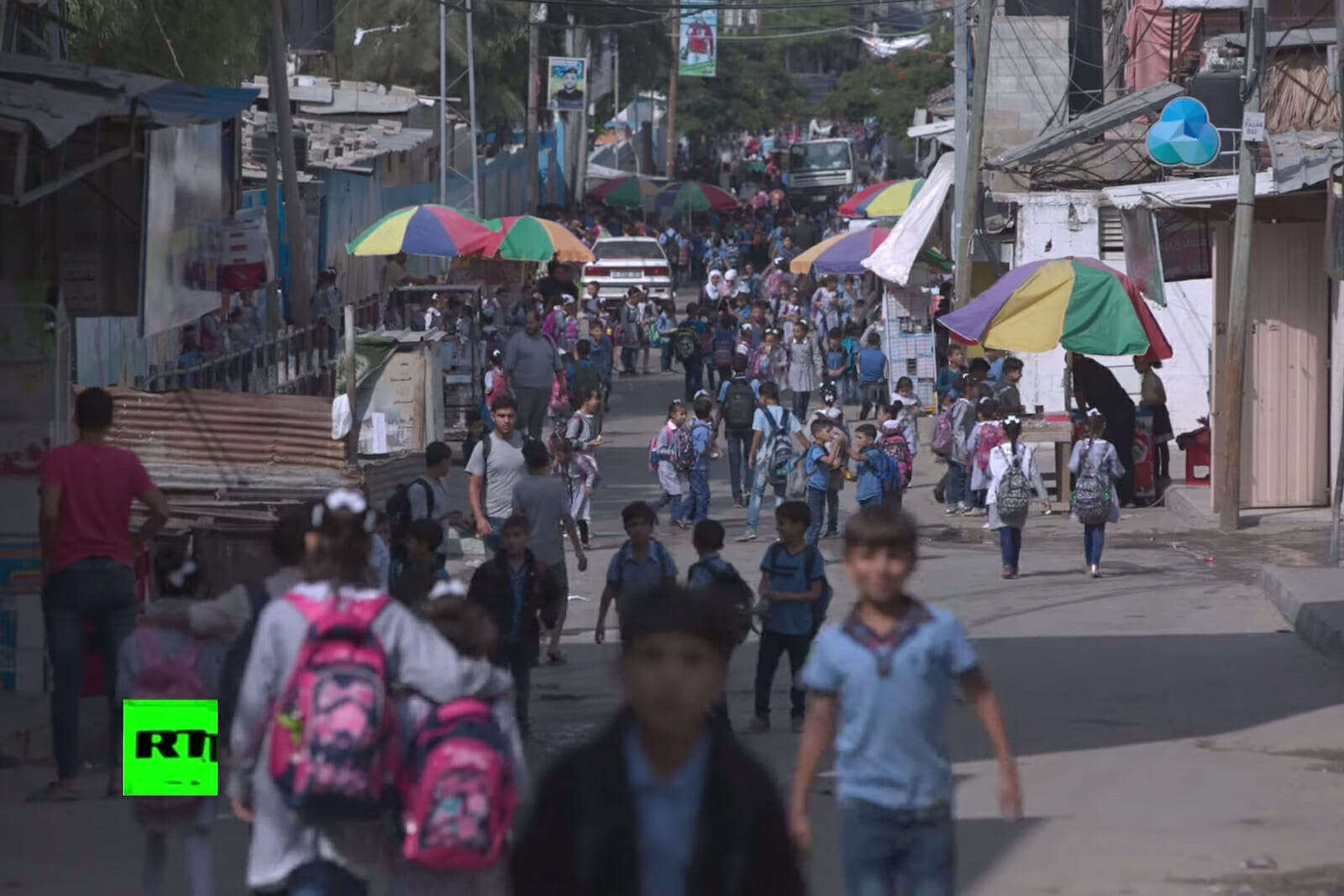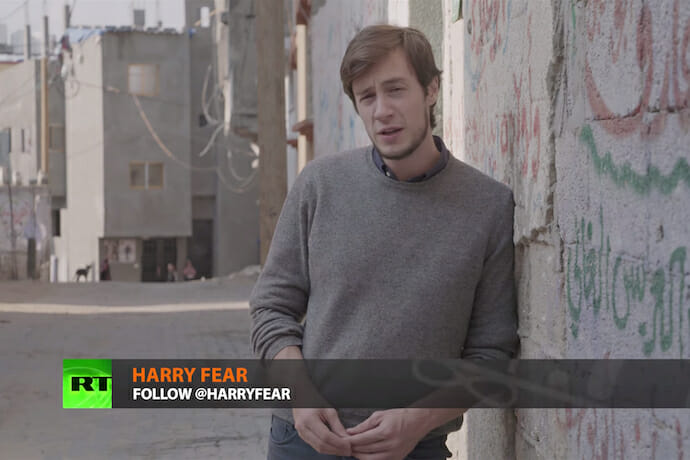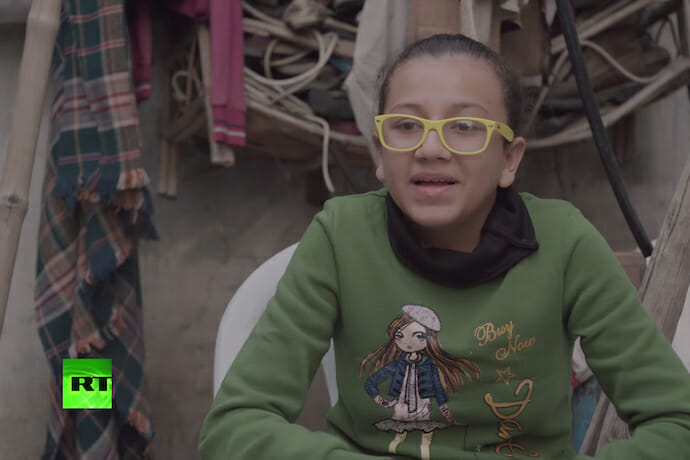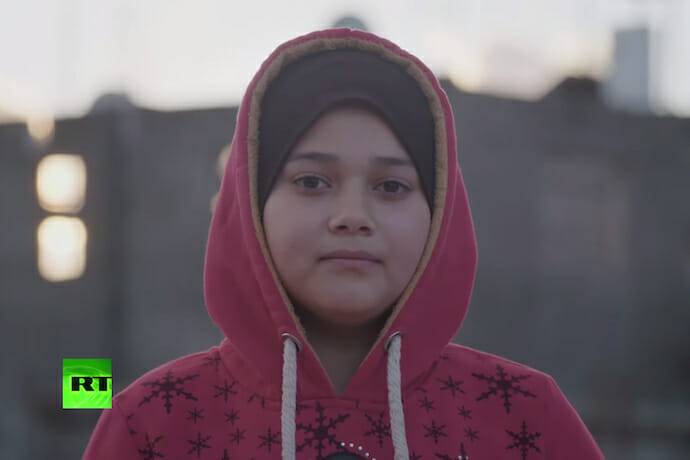
Conversation with Filmmaker Harry Fear on his new film, ‘Gaza: Still Alive’
“Gaza is a unique place.” Thus opens Harry Fear’s newest film, “Gaza: Still Alive,” a documentary about how the Israeli blockade is impacting the mental and physical health of Gazans living in the impoverished Gaza Strip. His other credit includes “Killing Hamid: Starting the Gaza War.”
The film wisely avoids focusing too much on the blockade itself and an examination of the dysfunctional nature of Palestinian leadership. That in itself is a weighty topic that has been addressed at length in any number of films and documentaries.
Instead, Harry Fear (@harryfear) interviews several children, psychologists, and doctors who are suffering, either directly or indirectly, by Israel’s blockade of the Gaza Strip.
Our conversation, conducted via email and edited only for content, is below.
Can you describe what guided you to make “Gaza: Still Alive”?
I have been following the situation in Gaza in one way or another for a decade, and have covered two wars there as a news correspondent and witnessed several flare-ups.
Gaza has experienced three major wars over the last decade. For adults and children alike the environment is what’s called “traumatogenic.” You can’t escape at least trace levels of trauma.
Under a politically and militarily motivated blockade by its neighbours, Gaza is long down the road of an ongoing war of wills with Israel; the latter wishing to break the will of Gaza’s people. In essence then, Gaza’s conflict with Israel is in part, at base, a psychological war.
As I see it, more broadly, Gaza’s story is one of both steadfastness and suffering. Both the spirit of resistance and the story of suffering run deeply through the collective and individual psychologies of the Strip’s people.
And on visiting Gaza after a long period away covering other stories, it seemed fitting to pick up the storytelling with a new, deeper angle. This all led to this focus on the psychological angle, with questions about mental health.
It was also important for me to produce a film that offered something of a fresh look at Gaza, that subverted the normal ‘war porn’ and ‘suffering porn’ storytelling clichés. I hoped that mental health then – also much abuzz in the West recently – could offer something of a fresh angle to look again at Gaza’s plight.
How difficult was it for you to make this film? Did you experience a lot of problems with trying to enter Gaza and film at length?
It was a difficult film to make inasmuch as it was a deeply sobering, even depressing, story to work on for several months. But generally speaking the logistics of making the film were straightforward.
Getting clearance to access Gaza from the Israeli side was straightforward as an RT Documentary Correspondent.
It’s an interesting anecdote to share that TV crews have to guarantee the Israeli authorities that they won’t leave any filming equipment in Gaza as a condition of entry. One has to assume that this is part of the psychological warfare: to add friction to Gaza’s media production companies efforts to access new equipment.
Much of the documentary’s filming in Gaza was remotely directed and filmed by Sami Shehada, a Palestinian cameraman I’ve long worked with, and a chap I trust enormously at the personal and professional creative level. He followed the brief just beautifully and helped capture life in Gaza just as I felt it ought to be depicted: beautifully, with vivacity, but with sobering undertones of suffering.
Rather, one of the greatest difficulties with the film was getting tens of hours of Gazan-dialect Arabic translated accurately into English. In all, 10 people worked on the verbose and broadcast translations.
At the beginning of the film, you point out that “Gaza: Still Alive” isn’t necessarily about Palestinian reconciliation politics or the Israeli occupation. How did you decide to avoid a discussion about those two interrelated issues?
“Gaza: Still Alive” touches on politics only in passing, or as a means of answering the guiding questions about mental health: how and why are Gaza’s people suffering so badly at the psychological level?
I felt it important to frame the film and its inquisition around humanitarian – rather than political – questions, because quite honestly, anyone who has followed Gaza’s decades-long suffering (or the wider conflict’s dynamics) knows that honest political inquiry leads only to answers of deep cynicism, which in turn often numb hearts and minds. I wanted to re-approach Gaza with questions that would instead refresh people’s engagement with and compassion towards Gaza’s people.

Rather than reporting on Gaza’s worst or most shocking cases of mental ill-health and trauma disturbance, I wanted to apply the film’s humanitarian theme to the film-making’s character choice, too. So the film re-visits individuals who featured in my previous war-time news coverage of Gaza.
The film gives these individuals, who I already knew personally, the space and time to contemplate over and express their own personal mental health landscape, and have their message heard by the wider world.
Building and extending these existing relationships represented for me a continuation of the humanitarian story-telling theme – a notion confirmed by one of the film’s other characters, Hassan Zeyada of the Gaza Community Mental Health Programme. He told us that because Gaza is so often-starved of visitors from the outside world, being emotionally present with and merely smiling with Palestinians in Gaza during our time filming would be emotionally meaningful and psychologically-beneficial to those we had contact with.
In Aya and Malak’s cases, we took several hours to unveil each’s stories and glimpse the mental health landscape of their childhood worlds.
Aya lives with ongoing pain from her physical injuries, but that physical pain cues a sort of re-experiencing of her mental trauma injuries. And that dynamic of suffering is one that must apply to tens of thousands of Gaza’s war-injured; their physical scars or pains bringing attention to dark memories.

In young Malak’s case, who lives in one of the most densely-populated parts of the Strip, her still having ongoing war trauma symptoms is something so common as to be near-universal in Gaza. In candid footage of Malak with her brother-in-law, she talks about her over-sensitivity to mundane loud noises – what psychologists call an ‘exaggerated startle response,’ which is a common trauma symptom.
Between them, the two girls give us an insight into the average mental health ‘injuries’ of kids in Gaza, both those physically-injured and those non-psychically injured.
For many children born in the last five or six years, is this the new normal for them?
Perpetual insecurity seems to be the new norm for Gaza; and as such, after a decade of siege and violence, you would be hard-pressed to find anyone aged 8 or over who hasn’t experienced some war trauma symptoms.
The film builds up to address the mental health prognosis for Gaza in quite some detail. But as anyone can tell with a cursory glance, there is no reason to think that things are going to change for the better soon. And that rather hopeless over-arching reality is very much part of Gaza’s deep psychological suffering.
To put it differently: can you, yourself, imagine growing up in a place where there is no hope that you’ll ever feel really secure, or ever be able to leave your city or see the outside world?

You interview Dr. Jamal Dagdoogy and Mohammed Mansour with Physicians for Human Rights, an Israeli group. Does the Israeli government encourage this sort of outreach? Are they having an impact?
Physician for Human Rights visits Gaza every one to two months and does not only direct clinical work but also offers training to help the continuing professional development of Gaza’s mental health professionals. And, above all, they offer professional solidarity.
We heard how Physicians for Human Rights is the only N.G.O. in Israel that is permitted by Israeli authorities to enter Gaza. For security reasons, the state generally bans Israelis from entering the Gaza Strip over fears that Hamas will kidnap an Israeli Jew to use them as a bargaining chip to earn the release of hundreds of Palestinians from Israeli prisons.
That meant the testimony we heard from these two Israeli Arab psychologists, who regularly volunteer in Gaza but live in Israel, was of immense insight and value. As non-subjects of the siege on and suffering in Gaza, they spoke with an even greater level of sobriety and alarm than the psychologists we spoke to who are stuck in Gaza.
While you and others point out, Palestinians have a remarkable ability to cope. What is the breaking point?
I have no doubt Palestinians will continue to cultivate and hold firm, giving “meaning [to] their suffering” as part of their culture of resilience and resistance. Owing to this, I believe the collective will to (somehow) cope will live on.
But I’m under no illusion that at another level, some parts of the collective psyche have already been broken. When, for instance, drug abuse – otherwise taboo – increases as a result of people’s desperation, then social norms have obviously started to crack, which represents a kind of passing of the breaking point.
In our filming we also heard how Israel “has succeeded” to drive swathes of Palestinian youths to desperately seek a life outside of Gaza. That’s now happening even at the expense of Palestinians otherwise preferring to build lives in Gaza as a means of staying put on Palestinian territory to resist what they see as Israel’s aim to appropriate their land.
Can you go into the Trump administration’s decision to cut off funding for aid groups helping on the ground? Many speculate that this is a negotiating ploy to force the Palestinians to accept whatever deal is forced on them.
The Trump administration has lifted the veil on America’s longtime bias in favour of the Israeli government agenda.
Trump and Netanyahu and clearly well-aligned. That was confirmed most recently by Israel’s swift barring from Israel two U.S. Congresswomen at the suggestion of Trump.
In our research we heard how Palestinians have grown used to and tired of this kind of siding with Israel by Western governments. And it’s widely seen in Gaza that the Trump administration’s policies of pressuring impoverished Palestinians on the ground is part of an Israeli-approved strategy to weaken and isolate the Palestinians ahead of an attempt to impose on them an ‘Israel-first settlement’ to the conflict — a ‘settlement’ in which Palestinians will have neither full autonomy, nor meaningful security, nor remedy for the Palestinan refugee issue.
Can you speak to whether there has been a spike in suicides, domestic violence or drug use among Palestinians trying to cope?
We heard how depression, suicide, drug abuse, and even domestic violence have been increasing in recent years as the Strip’s situation has become ever desperate. These are all coping mechanisms for people’s pain and anguish.
Hanging over Gaza is a deep dread of the next war. For the Palestinians you spoke with, what are their opinions of Hamas and whether another war is inevitable?
We avoided talking about internal Palestinian politics during the film’s production, so as to better ensure civilians felt free to open up without implications of being seen as locally partisan one way or the other.
But it’s a known fact that Palestinians in Gaza live at the mercy of the ruling Hamas authorities.
I think it’s important to describe how Palestinians are not only at the mercy of the wider world’s acquiescence to Israel’s repression (what I call the ‘wider siege on Gaza’); and not only, secondly, at the mercy of the Israeli- and Egyptian-imposed blockade (the ‘immediate siege on Gaza’); but they are also at the mercy of an ‘internal siege on Gaza’ – that is the Hamas authorities’ increasingly desperate and authoritarian control of the Strip, which mimics some of the worst civil and human rights abuse tendencies of the Israeli regime itself.
It’s also worth noting from the psychological perspective that there is a fourth dimension of besiegement experienced by Palestinians in Gaza. That would be the self-imposed ‘Gaza syndrome’ (as some call it), which is an unavoidable ‘maladaptive’ coping mentality that allows Palestinians to survive the suffocating situation and war traumas without losing their minds, but which also inevitably hardens and limits otherwise normal responses to trauma and tragedy. To put it a simpler way, – as we hear in the film – for many in Gaza, their suffering is so great that they have no choice but to repress their experience of it in order to carry on “still alive.” So for some, they experience a lack of freedom to even fully experience and live out their own pain.
We saw while filming how the anticipation of ‘another war’ (or even ‘the next war,’ as some would refer to it) is completely normalised in life in Gaza. So embedded in that ‘Gaza syndrome’ is the idea that war can happen at any time and that a constant state of on edge vigilance is a part of life to maintain resilience and sanity. So for many, Gaza is a society soaked in ongoing actual trauma and anticipated trauma. For some, a life holed up in Gaza, in the absence of any respite, doesn’t even offer the chance to begin recovering from one’s mental injuries.
You spoke at length with Dr. Nafez Abu Shaban, the head of Al-Shifa Hospital’s burn unit. He described that despite the fact that his children are better off than most in Gaza, he’s saddened that they desperately want to leave. Does he understand their desire to leave to seek a better life?
Part of Palestinians’ decades-long culture of resistance has been the notion of ‘staying put’ on Palestinian territory as a mode of resistance against an occupation that seeks to steal their land. This has meant that some Palestinian families have built up lives in Gaza in spite of having the financial and immigration freedom to up sticks to another safer country (like Saudi Arabia or somewhere in Europe).
But what’s been developing in recent years is a sublimation of this concept at the expense of another ascendant ideal: that individual self-actualisation is another means of resistance (‘you will not stop me realising my individual potential despite your attempts to block my freedom and dignity’). As the situation in Gaza has worsened, people often see no choice but to aim to escape the Gaza “ghetto.” Young schoolgirl Aya expresses such an aspiration in the film; as does taxi driver thirty-something Ahmed. But the idea of leaving’s saturation as a talking point is a newly-widespread phenomenon.
Given this, and with a staggeringly high youth unemployment rate, hovering around 60%, it’s no surprise that especially middle-class Gazan youth aspire to leave Gaza to seek a better life.
What drives doctors like Dr. Nafez Abu Shaban to continue to practice medicine despite the lack of basic supplies at clinics and hospitals?
In the film, we hear Dr. Abu Shabon’s agonising descriptions of life in Gaza. Dr. Abu Shabam has seen some of the most horrendous injuries that the Gaza wars have produced, but he carries on in spite of this. At the psychological level, although he has been exposed to deeply traumatised individuals and even vicarious trauma himself, he drives on and with the willpower to help others. Such individuals heroically make do with what they can in terms of limited medical resources.
But in filming, we also heard how some of Dr. Abu Shaban’s clinical colleagues and friends haven’t been able to continue under the stress they’ve experienced.
What has to change on the ground in Gaza for a change in circumstances? Is it as simple as Israelis suggest that Hamas is the problem?
Hamas – founded in 1987, almost forty years after the 1948 founding of Israel – clearly is a symptom of a deeper problem. For many, Hamas represents a destructive militant tendency of Palestinian resistance. Inasmuch as that is true, Hamas then would be, metaphorically, like an unhealthy drug habit – a maladaptive response to an unbearable situation.
The unbearable situation is the “continual, unrelenting, multifaceted catastrophe,” as Canadian psychologist John Soos has put it. As I see it, the unbearable situation is the status quo in which Palestinians’ liberation is blatantly barred: their security, statehood, human and civil rights, and dignity as a people – that is, their freedom – are disallowed.
For things to change in Gaza, there would have to be a geopolitical power shift that unknots the U.S.-Israel monopoly on the direction of the Israel–Palestine conflict. The current trajectory is one of more land theft in the West Bank, more suppression of life in Gaza, and fewer civil rights for minorities in Israel itself.
A disruptive thorn in the side of this U.S.-Israel titan would be anything that helps restore Palestinians’ humanity; that helps undo the U.S.-Israeli treatment of them as unpeople (as subjects to be controlled and undeserving of security, rights or dignity).
Such a thorn could be something like a UK Labour government, led by longtime Palestinian rights supporter Jeremy Corbyn, recognising a Palestinian state and its people’s inherent rights to security, self-determination, and autonomy. That could well cause a geopolitical shift that could actually undo some of the macro geopolitical mechanics that currently chokehold Gaza.
Finally, Israel’s maximum pressure campaign, or siege, on Gaza is suffocating Gazans. What impact is it having on Hamas and its leadership?
Hamas isn’t a singular entity. Parts of its politburo aren’t even in the Palestinian territories but are in exile in the wider region. Importantly, that has meant that some high-level Hamas decisions in the past have had outcomes otherwise different to if the entire Hamas leadership were immediate subjects of the siege on and suffering in Gaza. Hamas’ military and political strategy during the summer 2014 Gaza War is the prime example. Hamas held out for 51-days, not agreeing to a ceasefire but instead calling for an end to the siege, as Israel pummelled entire neighbourhoods of the Strip, killing hundreds of innocent civilians. As is self-evident, the siege remains in place.
But as time goes on, and the situation in Gaza gets more desperate, the ruling Hamas authorities in Gaza – last democratically mandated over a decade ago in 2006 elections – ascend in their desperation, too.
But how does this manifest? We’re talking about raised and new taxes on consumers to fund local authorities – like extortionate taxes on cigarettes. And at the other end of the spectrum we’re talking about the ever brutal repression of protest and dissent – like intimidating young bloggers.
The maximum pressure campaign is felt by Hamas then, but so far the authorities have diverted this stress onto the already-suffering wider civilian population.
With these multidimensional stresses, we hear in the film how Palestinians carry on: are “still alive.”
“Gaza: Still Alive,” first broadcast in June, was just released online at RT.com on 9 August. The film is also available to stream at the official documentary site GazaStillAlive.com.

